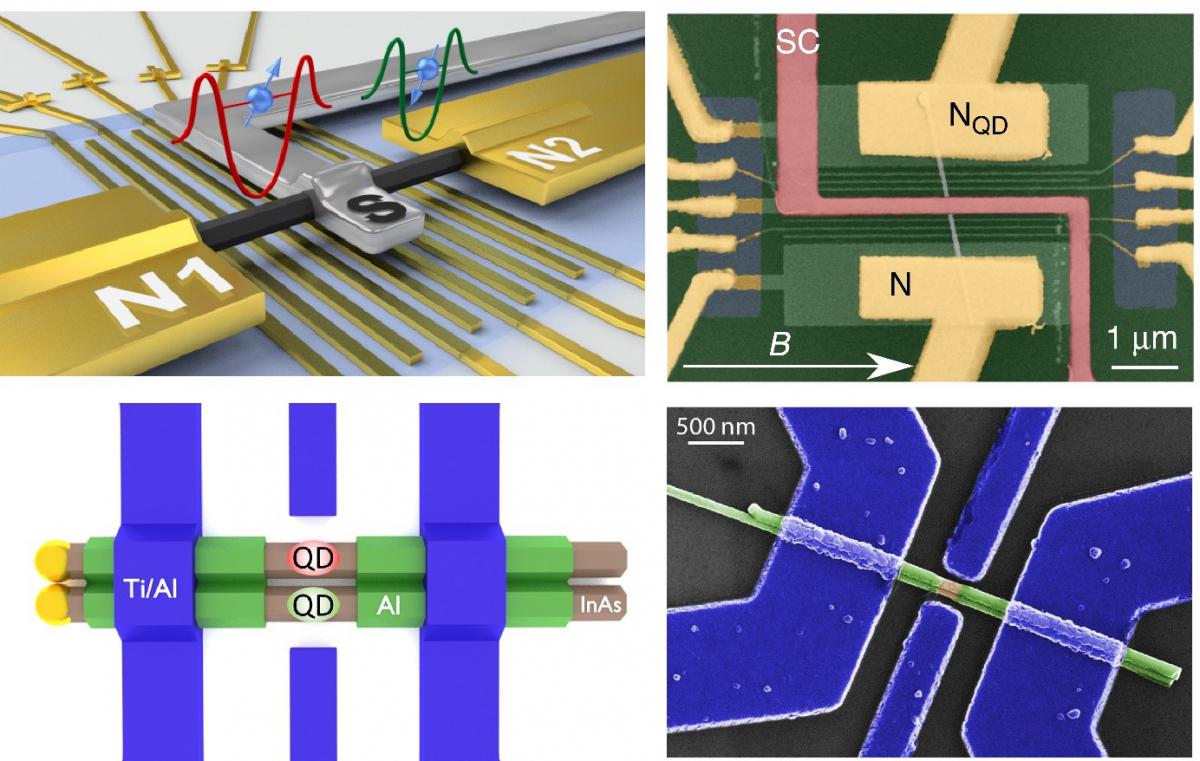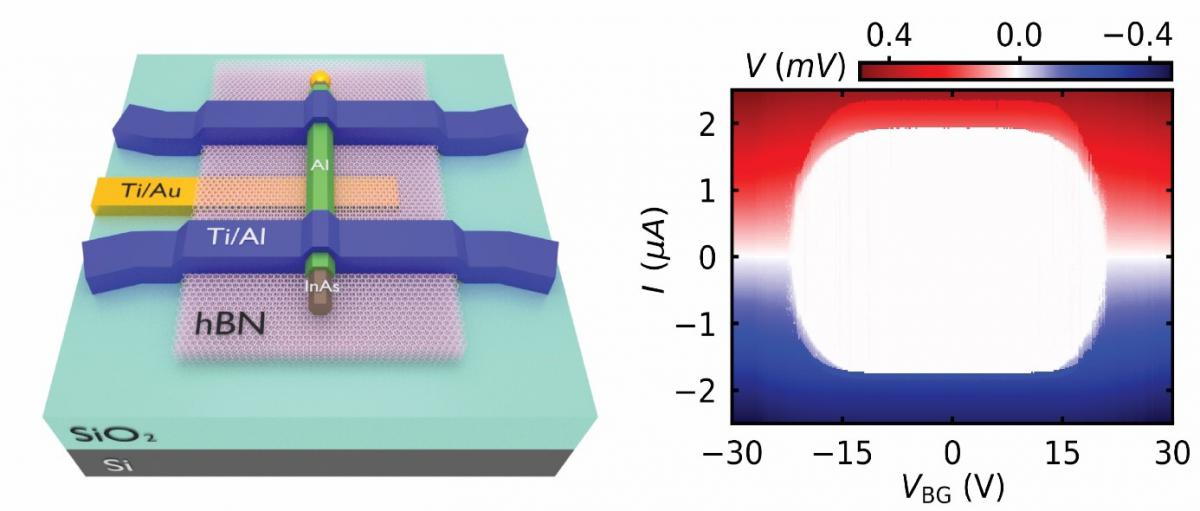One of the main directions of our group to investigate nanodevices coupled to superconducting circuits. The main platforms for these hybrid nanodevices are InAs nanowires and graphene.
Nanowires are effectively 1D systems, with a diameter of ~50-100 nm and a length of a few microns, and are one of the most interesting systems for fundamental research. In particular, indium-arsenide nanowires which has been in the centre of our research has several attractive properties. InAs nanowires have strong spin-orbit coupling, and high g-factor (up to 15) and the Fermi energy can be tuned by local gating.
Graphene, a single atomic layer of graphite, is the first 2D material discovered. It host electrons with Dirac spectrum, can be easily combined with other materials to change its properties via proximity effect. Graphene samples can have large mobilities, easily adjustable Fermi-level and they are easy to couple to superconducting electrodes.
We fabricate the nanocircuits based on nanowires with e-beam lithography and the experiments are carried out at cryogenic temperatures, down to 10mK.
Hybrid quantum dot circuits
Over the last few years we have investigated the coupling of superconducting electrodes to quantum dots realized in InAs NWs. One of the central device architectures are shown in Fig 1., top row, and called Cooper-pair splitter circuit, which can be used as a source of entangled electron pairs. The electronic ground state of a superconductor is composed of spin singlet electron pairs, so-called Cooper pairs. In a Cooper pair splitter nanocircuit two QDs are coupled to a superconducting lead, the Coulomb repulsion on the QDs force the incoming electron pairs to split and leave via opposite normal leads. The first successful Cooper pair splitter was realized by S. Csonka and co-workers [1]. In later studies we could show gate tunability of the splitting efficiency by tuning the parameters of the QDs, and the efficiency was improved to approx. 30% by changing the device geometry and using a wide gap superconductor [2]. Moreover, we have demonstrated fascinating non-local interference effects arising in these nanocircuits [3]. We also have put forward ideas how to address the singlet nature of the outgoing electrons using the toolbox of spin qubits [4].
The ideal operational condition for Cooper pair splitter is when the QDs are weakly coupled to the SC electrode. We have also investigate the opposite limit: in this case Andreev and Shiba bound states are formed on the dots. We have shown in one of our experiment that such Shiba state can have 1-2 order or larger extension in 1D systems compared to higher dimensional cases [5]. This paves the way to Shiba chains, where a set of QDs are only coupled via Andreev processes through a SC electrode. Moreover, if the two dots are strongly hybridized via the superconductor, than an Andreev or Shiba molecule forms. We have studied the signature of this Andreev molecular system theoretically [6] . Recently, using a novel platform of parallel InAs nanowires connected by an epitaxial Al shell, we have managed to demonstrate for the first time the existence of an Andreev molecular state [7].
 |
| Top left row: Schematics and false coloured SEM image of a Cooper pair splitter device. Bottom row: double nanowire circuit used for generation and detection of the Andreev molecule. |
Finally, we have used built-in InP barriers to perform spectroscopy measurements on Andreev states in InAs wires [8]. These barriers could be used in further CPS and Andreev molecular devices.
Metallic gating
 |
| An epitaxial Al layer (grown around an InAs core) based weak link separated from local gates by hBN. As the right panel shows, the supercurrent in the metallic strip can be turned off using electrostatic gating. |
Recently it has been found that for macroscopic metallic superconductors, with sizes on the order of tens and hundreds of nanometres, the superconductivity can be switched off using electrostatic gating. This effect is really surprising since the gate electrode disturbs superconductivity on a much larger length scale than the screening length. Whereas the origin of the effect is unclear (gating effect or hot quasi-particle injection, or other mechanisms), it can have clear applications as superconducting field effect transistor in novel fast and lower consuming superconducting computer architecture.
We are investigating this effect on nanowire systems covered with an epitaxial superconductor. Here the NW acts as a template. We have found, that in epitaxial Al coated NWs this effect is present and cannot be simply explained with hot quasi-particle injection [9].
Graphene nanocircuits
We investigate graphene heterostructures coupled to SC electrodes. In collaboration with the group of Christian Schönenberger, at University of Basel, we have investigated double bilayer graphene Josephson junctions. At large magnetic field this system shows a quantum spin Hall state, whereas at low fields current phase relation measurements were performed using purely in-plane magnetic fields [10]. We have also investigate SC tunnel probes as sensitive tools to obtain non-equilibrium distribution of electrons [11].
Our main focus is on understanding superconductivity in presence of induced spin-orbit coupling in graphene. For that we study Josephson junctions and also heterostructures placed in a SQUID geometry to probe the CPR in collaboration with group of Srijit Giswami at TU Delft.
 |
|
Top: Graphene based Josephson junction, where an induced spin-orbit interaction is present due to encapsulation in WSe2. Measurements show gate tuneable supercurrents. Bottom: SQUID geometries (sketch and optical image) used to measure the superconducting current-phase relation. |
References
[1] Hofstetter L, Csonka S, Nygard J, Schonenberger C: Cooper pair splitter realized in a two-quantum-dot Y-junction, NATURE, 461, 7266 (2009)
[2] Fülöp G, d'Hollosy S, Baumgartner A, Makk P, Guzenko V A, Madsen M H, Nygård J, Schönenberger C, Csonka S: Local electrical tuning of the nonlocal signals in a Cooper pair splitter, PHYSICAL REVIEW B, 90, 23 (2014)
[3] Fülöp G, Domínguez F, d’Hollosy S, Baumgartner A, Makk P, Madsen M H, Guzenko V A, Nygård J, Schönenberger C, Levy Yeyati A, Csonka S: Magnetic Field Tuning and Quantum Interference in a Cooper Pair Splitter, Physical Review Letters 115, 227003 (2015)
[4] Z. Scherubl, A. Palyi, S. Csonka: Probing individual split Cooper pairs using the spin qubit toolkit, Physical Review B 89, 205439 (2014)
[5] Z. Scherübl, G. Fülöp, C. P. Moca, J. Gramich, A. Baumgartner, P. Makk, T. Elalaily, C. Schönenberger, J. Nygård, G. Zaránd, Sz. Csonka, Large spatial extension of the zero-energy Yu-Shiba-Rusinov state in magnetic field, Nature Communications 11, 1834 (2020)
[6] Z. Scherübl, A. Pályi, Sz: Csonka: Transport signatures of an Andreev molecule in a quantum dot -- superconductor -- quantum dot setup, Belstein J. of Nanotechnology, 10, 363 (2019)
[7] Olivér Kürtössy, Zoltán Scherübl, Gergő Fülöp, István Endre Lukács, Thomas Kanne, Jesper Nygård, Péter Makk, Szabolcs Csonka, Andreev molecule in parallel InAs nanowires, arXiv:2103.14083
[8] T. Elalaily, O. Kürtössy, V. Zannier, Z. Scherübl, I. Endre Lukács, P. Srivastava, F. Rossi, L. Sorba, Sz. Csonka, P. Makk, Probing proximity induced superconductivity in InAs nanowire using built-in barriers, Phys. Rev. Applied 14, 044002 (2020)
[9] Tosson Elalaily et al., arXiv:2106.06619 (2021)
[10] David I. Indolese, Paritosh Karnatak, Artem Kononov, Raphaëlle Delagrange, Roy Haller, Lujun Wang, Péter Makk, Kenji Watanabe, Takashi Taniguchi, Christian Schönenberger, Compact SQUID realized in a double layer graphene heterostructure, Nano Letters., 10, 7129 (2020),
[11] S. Zihlmann, P. Makk, S. Castilla, J. Gramich, K. Thodkar, S. Caneva, R. Wang, S. Hofmann and C. Schönenberger, Nonequilibrium properties of graphene probed by superconducting tunnel spectroscopy, Phys. Rev. B. 99, 075419 (2019)

